Sections of the site
Editor's Choice:
- How to unlock ariston washing machine
- Pros and cons of LED lighting
- Pulse relay: device and connection
- How to calculate the illumination of a room with LED lamps?
- Plastic box - do-it-yourself aesthetic view of electrical wiring
- Electricity consumption of a warm floor: electric and film
- Installing a pump in a well: how to properly install pumping equipment
- Electrician Toolkit Overview
- How to choose a water heater: the most complete list of evaluation criteria
- 1 acoustics on the example of Sven SPS-860 and Realtek ALC889 codec
Advertising
| How to use a multimeter correctly |
|
The life of a modern person is surrounded by consumers of alternating (household appliances, power tools) and direct (cars) current. All electrical devices are assembled according to the compiled electrical circuits, the failure of the components of which leads to breakdowns of complex mechanisms. A home craftsman, armed with special equipment and the ability to understand the intricacies of electrical wires, can not only find the reason for the loss of efficiency of a wall-mounted plasma or an automatic washing machine, but also return the former colors to the TV screen, and delight the hostess with the buzzing of an indispensable assistant. A multifunctional multimeter is a must have for every DIYer, so it's important to know how to use it properly. What is a multimeterA multimeter is a device that measures the parameters of an electric current. Moreover, the tester - another name for the device - combines the functions of measuring instruments that determine the current strength, mains voltage and conductor resistance. Using a multimeter, they look for breaks in electrical networks, check the performance of electronic components: diodes, capacitors, triodes and other elements.  Multimeters are divided into analog (pointer) and digital; in analog testers, the measurement result is shown as a deviation of the arrow on a graduated scale, and digital multimeters display information in numbers on the display Multimeters are divided into analog (pointer) and digital; in analog testers, the measurement result is shown as a deviation of the arrow on a graduated scale, and digital multimeters display information in numbers on the display Lightweight, compact, easy-to-use tester is an indispensable helper for a home craftsman who will help to quickly and accurately determine the cause of malfunctions in the electrical circuits of household appliances, cars, home electrical wiring, power tools. Scheme of operation of an analog tester and a digital multimeterAt first, multimeters were analog (pointer) and were called testers. Their package necessarily includes two wires with probes, which close the sections of electrical wiring, electronic components, contacts. The result of the measurements was determined by the position of the arrow on one of the scales: separately for voltage, own for current strength, individually for resistance.  The principle of operation of the mechanism of a magnetoelectric system is the interaction of an electric current passing through the winding of the frame with the magnetic field of a permanent magnet The principle of operation of the mechanism of a magnetoelectric system is the interaction of an electric current passing through the winding of the frame with the magnetic field of a permanent magnet Often the scales are made in different colors to improve visual perception. The main components of an analog multimeter: a permanent magnet, a moving induction coil, an arrow connected to it and a counteraction spring. The main mechanism in the analog tester is the pointer head, which is a rather sensitive electromechanical device made in the form of a miniature coil suspended on springs. The current, passing through the turns of a coil placed in a magnetic field, turns it at a certain angle, thereby deflecting the arrow - fixed on it - and, overcoming the resistance of the spring, sets it in a specific position. This position of the arrow on the marked scale in the form of an arc is the measured value of the desired parameter.
It is clear that the accuracy of such a tester depends on several factors: position in space, mechanical impact (for example, hand trembling), ambient temperature. The analog multimeter provides for the presence of a special control device that helps to bring the arrow to zero before starting measurements. 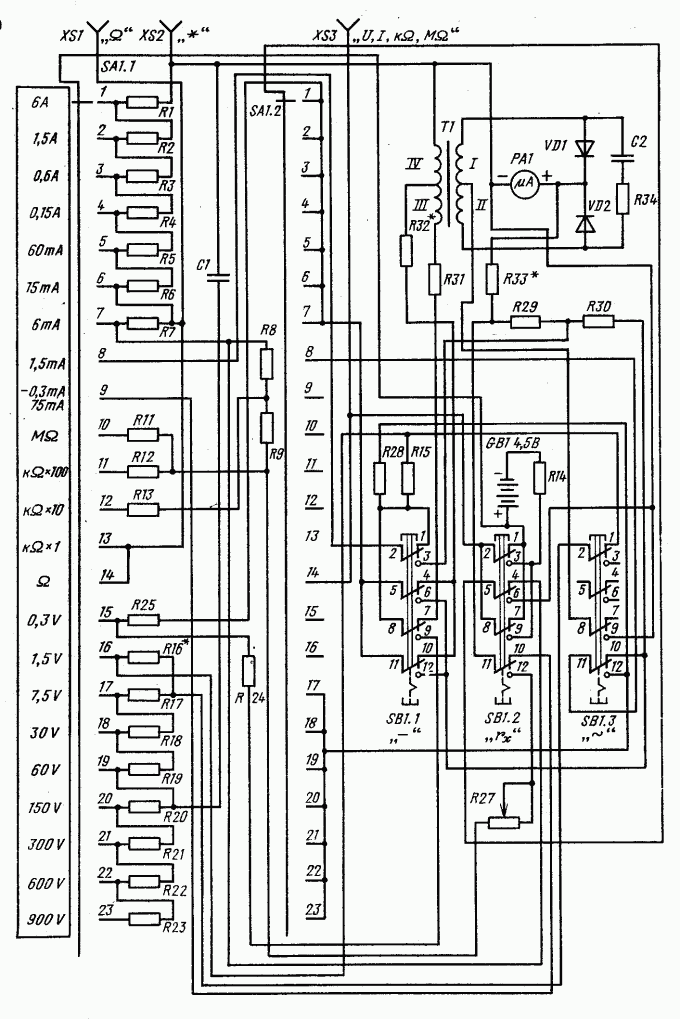 The diagram shows a circuit diagram of a simple analog multimeter measuring with shunt resistors. The diagram shows a circuit diagram of a simple analog multimeter measuring with shunt resistors. The pointer device in the device is simple.  As a power source in all types of multimeters, a KRONA battery is used. As a power source in all types of multimeters, a KRONA battery is used. Its design consists of a set of carefully selected high-precision resistor shunts of various ratings, several diodes, a microammeter, and its own power supply used to measure resistances. 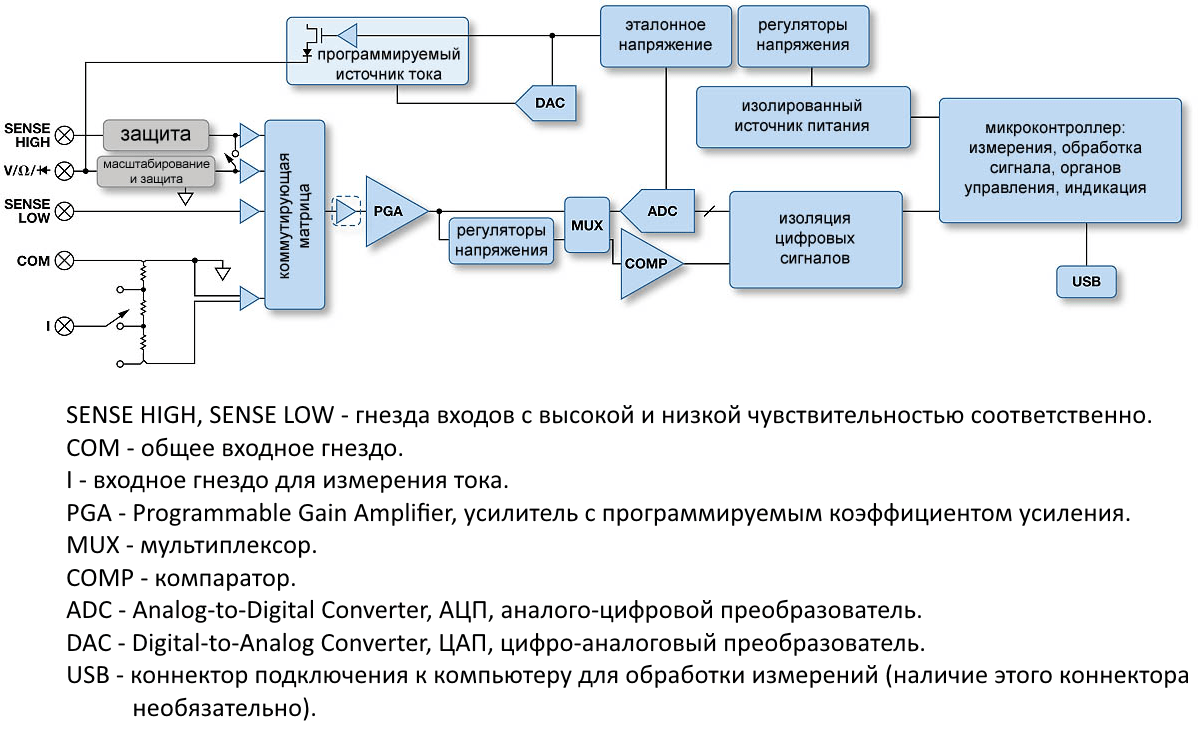 Currently, digital multimeters are based on the achievements of microelectronics, which is characterized by an organic unity of physical, design and technical and circuitry aspects. Currently, digital multimeters are based on the achievements of microelectronics, which is characterized by an organic unity of physical, design and technical and circuitry aspects.
In terms of cost, a digital meter is not much more expensive than a pointer analogue, because mass production of microelectronic chips has long been established, so their cost is low. The convenience of using a digital multimeter lies in its advantages:
Purpose of the deviceCompact, pocket-type multimeters are used to measure the characteristics of electric current. But the measurement area of digital analogues is much wider. They can measure the capacitance of capacitors, inductance parameters, current frequency, heating temperature of conductors. You can define the range of parameter change, the percentage of measured values of the same type. The only function that is not available for them is the display of the measurement dynamics. But the arrow tester easily demonstrates the intensity of changes in the speed of the arrow (instantaneous, gradual, very slow). Analog multimeters can also be endowed with additional functions, but then the arrow testers will become bulky, heavy, inconvenient to use. Application areaAt home, a multimeter checks, as a rule, the absence or presence of current in the supply wires. In other words, the fact of a break in a cable or conductors, as well as the state of contacts in electrical circuits, is being investigated. 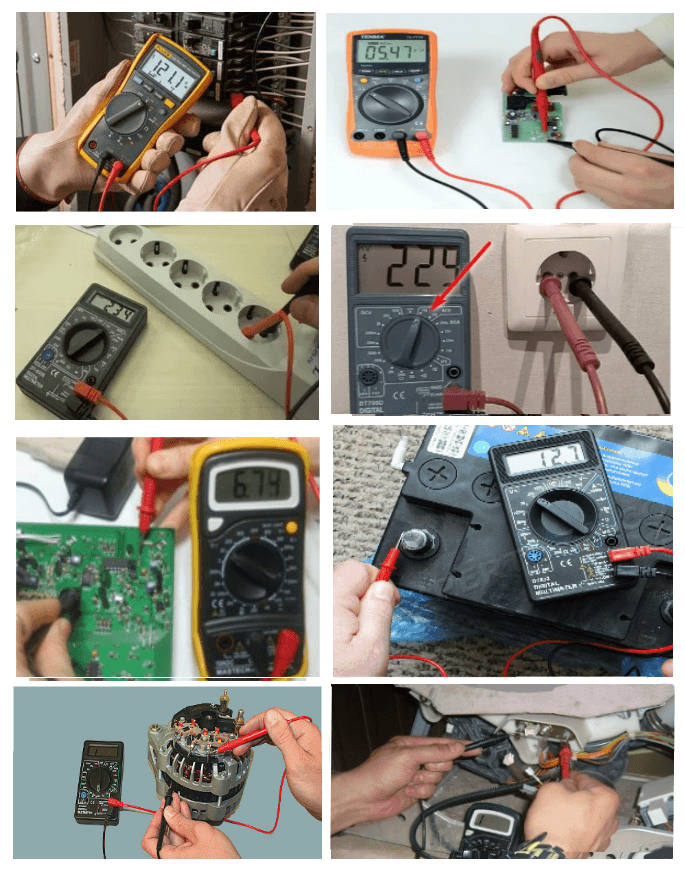 Digital multimeters are compact in size and powered by batteries, but at the same time they advantageously combine ease of use, high accuracy and versatility at a low price. They have taken a firm place in the arsenal of both a radio amateur and an engineer. Digital multimeters are compact in size and powered by batteries, but at the same time they advantageously combine ease of use, high accuracy and versatility at a low price. They have taken a firm place in the arsenal of both a radio amateur and an engineer. In these cases, the instrument switches to the ohmmeter function. More experienced users can measure the voltage, frequency and current in the mains. Advanced owners of a multifunctional device check the performance of:
More recently, the tester was only in the arsenal of electricians and radio amateurs, but today it is owned by millions of users due to the ease of operation control, low cost, compactness, and the presence of many objects for measuring DC and AC parameters in our everyday reality. Video: how to use a multimeter. Application in everyday life and auto repairVarieties of multimetersIt is important to know that multimeters with different sensitivity ranges are used for different purposes. It is this most important parameter that determines the scope of use of each particular model. A multimeter that measures the voltage of cans in a car battery will not be able to measure the low voltage voltage of current sources, since their values are expressed in millivolts. At home, fuses, sockets, incandescent lamps, heating elements, integrated circuits, transistors, automotive electronics are measured with a multimeter. All these measurements are easily handled by a digital multimeter, which is most popular among home craftsmen. 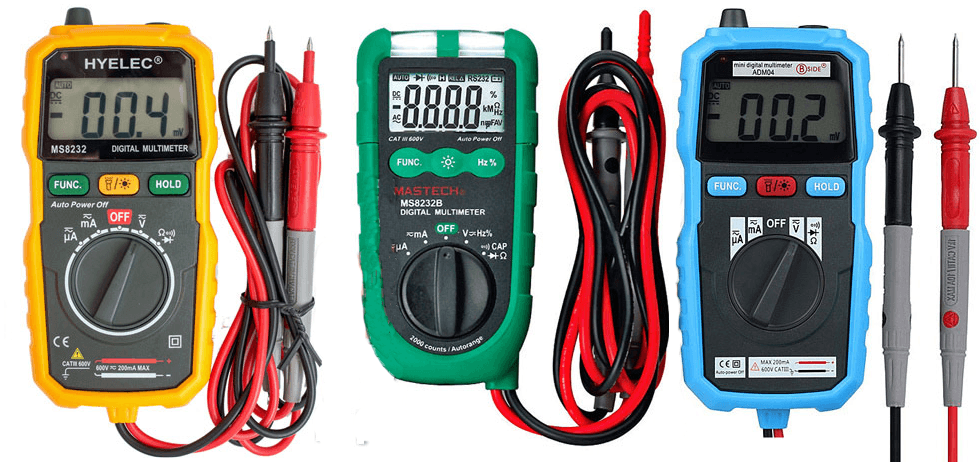 Household digital multimeters differ from each other in appearance, measurement accuracy, calculation algorithm, and the presence of various features. Household digital multimeters differ from each other in appearance, measurement accuracy, calculation algorithm, and the presence of various features. The very name of the multimeter - most accurately indicates the purpose of this multifunctional device. There are so many varieties of testers that anyone can purchase a model that meets their requirements for this device. And requests can be to the design, the range of measured values, the set of functions. Today's multimeter, in addition to measuring capabilities, can be endowed with the capabilities of various calculations and plotting a graphical representation of signals. Enough has already been said about digital and analog models. Consider other types of multimeters. Clamp metersIt is known from school physics that a voltmeter is connected in parallel to a circuit, and an ammeter is connected in series. In order to create a gap in a high-voltage circuit to measure the current strength, clamps were invented. The first versions of electric clamps were presented in the form of a transformer, in the secondary winding of which an ammeter was connected. The readings of such a device had to be recalculated, so when measuring the current strength, the influence of the transformation ratio was not taken into account. Such clamps could only measure alternating current, they do not work with direct current. In modern current meters, instead of an ammeter, there is a Hall sensor, which is able to determine and record the presence and strength of the field for both alternating current and direct current. 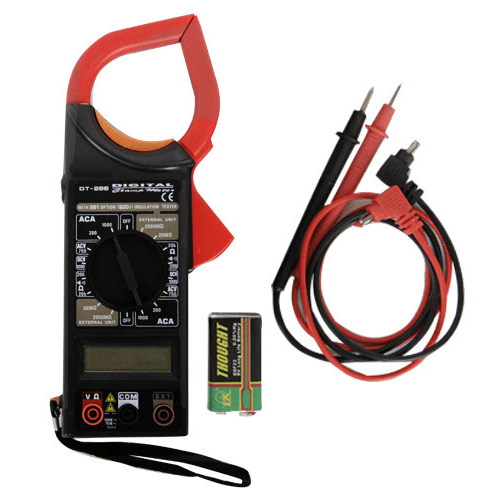 The DT-266FT clamp meter is an inexpensive popular series designed for AC current, DC and AC voltage, resistance measurement, diode testing, frequency measurement The DT-266FT clamp meter is an inexpensive popular series designed for AC current, DC and AC voltage, resistance measurement, diode testing, frequency measurement There are two types of measuring clamps: professional ones for measuring networks with voltages above 1000 V and household ones - voltages less than 1000 V. The design of devices of this type is constantly being improved today, with their help such complex tasks are solved:
Video: how to use the multimeter and current clamp DuMa8819Photo Gallery: The Best Digital Testers of 2018The most accurate budget tester The best price The most compact tester Table: rating of models of digital testers in 2018
Instructions for useTo an unprepared person, it may seem difficult to manage this device. Buttons, switches, names in English and other things that are not very clear. But in fact, there is nothing tricky if you understand the principle of measuring various parameters.
Introduction to multimeter languageAlmost all multimeter models are made in China, so the names on them are written in English.  On the front panel of the tester, all the inscriptions are made in English, and even using the abbreviation On the front panel of the tester, all the inscriptions are made in English, and even using the abbreviation Abbreviations are applied in Latin, which denote:
Voltage measurement with a DT830 multimeterPreparing the multimeter to start measuring the magnitude of the alternating voltage:  If a much smaller figure than 700 appears on the display, and zero is in front of it, then the switch should be moved to a lower voltage value - 200. When measuring DC voltage, the wires with the probes remain in their sockets, and scroll the switch to the DCV area. The order of measurements is the same: start with the largest modes and gradually switch to the desired level. Important note: when measuring DC voltage, put a red probe on the positive contact, and a black wire on the negative contact. However, if the polarity is incorrect, the display will show a value with a minus sign. Video: how to measure the voltage in a 220 volt outlet for beginnersMeasuring current with a multimeter DT830BThis type of instrument can only measure direct current. Sequencing: 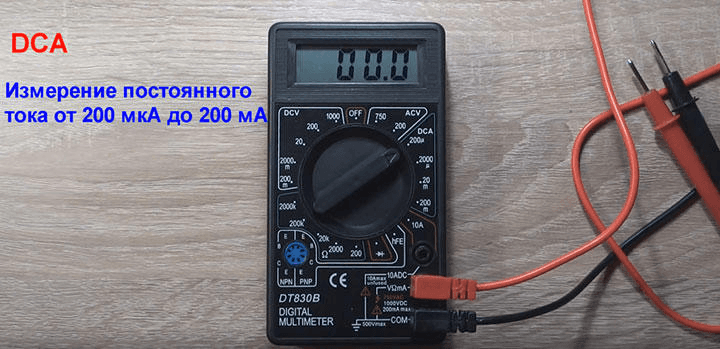 If the device shows a small value, then rearrange the red wire to the VᘯmA connector.
Video: how to measure the current in a flashlightResistance measurementTo measure resistance:  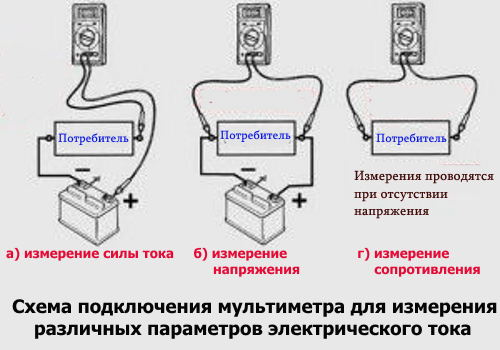 When measuring current, the multimeter is connected in series, when measuring voltage and resistance - in parallel When measuring current, the multimeter is connected in series, when measuring voltage and resistance - in parallel Video: multimeter resistance measurementringingThis technique is used to find out if there is an open in the circuit or if it is not damaged. For ringing, the switch is placed in the diode test position. 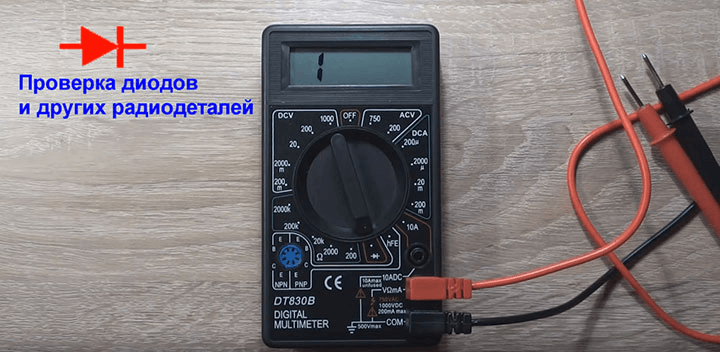 The dialing mode is performed when the pointer is in the position - checking diodes The dialing mode is performed when the pointer is in the position - checking diodes Checking capacitors, diodes, transistorsThe purpose of the event is to determine the presence of resistance, in the same way as the continuity of conductors. The procedure is as follows:
The multimeter display will show numbers indicating the forward resistance of the diode. When changing the polarity (the probes are swapped), the number one should be displayed on the screen (the diode is working). If the unit appears when measuring direct resistance, the diode has burned out. Typical malfunctions of digital multimeters and their causesFirst of all, you should check the performance of the battery. If necessary, replace the CROWN. Do not leave the probe in the “10A” socket after the end of the measurements! A short circuit will burn out the circuit board tracks under the switch. It's not recoverable! Table: Common DMM Problems
How to work with a multimeter is described in detail in this video. Video: how to use a multimeter |
|||||||||||||||||||||||||||||||||||||||||||||||||||||||||||||||||||||||||||||||||||||||||||||||||||||||||||||||||||||||||||||||||||||||||||||||||||||||
New
- Duel (story), plot, heroes Kuprin duel read online summary
- The shortest retelling of "Scarlet Sails
- Rating of the best perfumes for women
- Top spirits. Spirit Rating. Other Factors Affecting Durability
- The largest meteorites that fell to Earth (22 photos) The fall of the meteorite recently
- Geysers mora top vega Operation and repair work
- How the son of Andrei Dementiev died
- Alexander Grinev Alexander Grinev married Buzov blog
- Why did the Hands Up group break up?
- How wives cheat on their husbands How to spot signs of a cheating wife in behavior

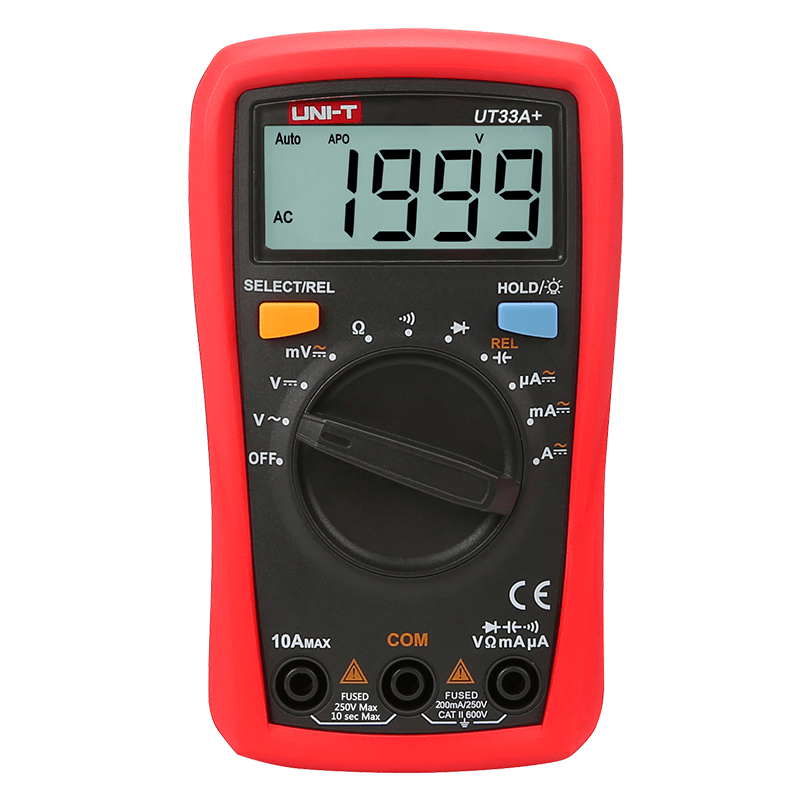 Best Automated Tester Most Reliable Multimeter Best Auto Electrician Multimeter Best Value for Money Most Versatile Tester
Best Automated Tester Most Reliable Multimeter Best Auto Electrician Multimeter Best Value for Money Most Versatile Tester




